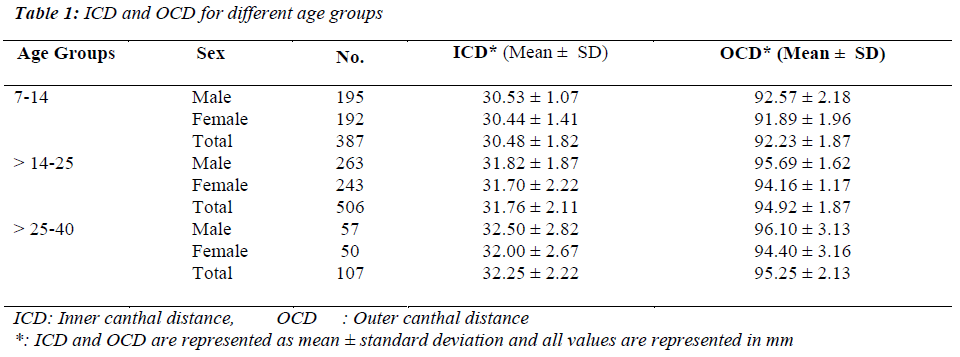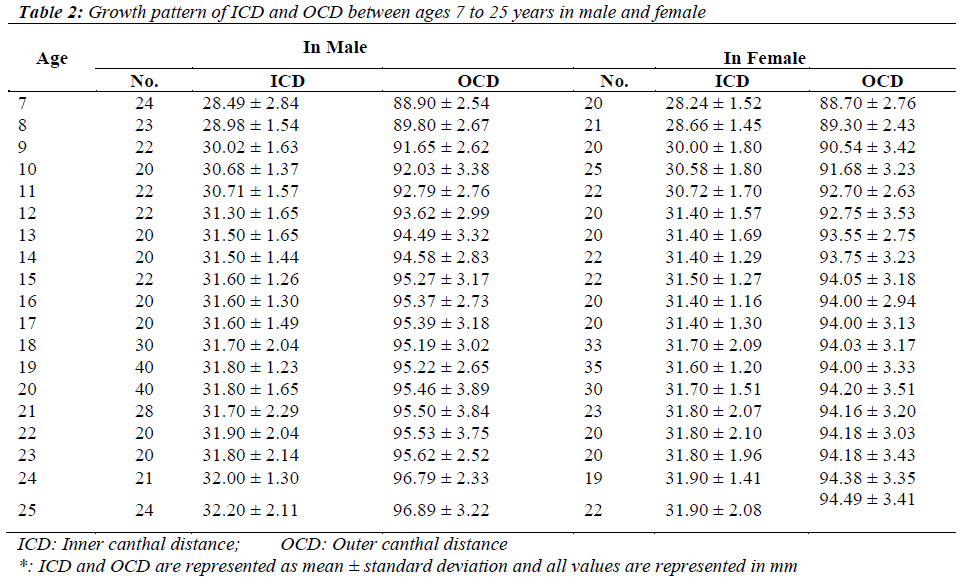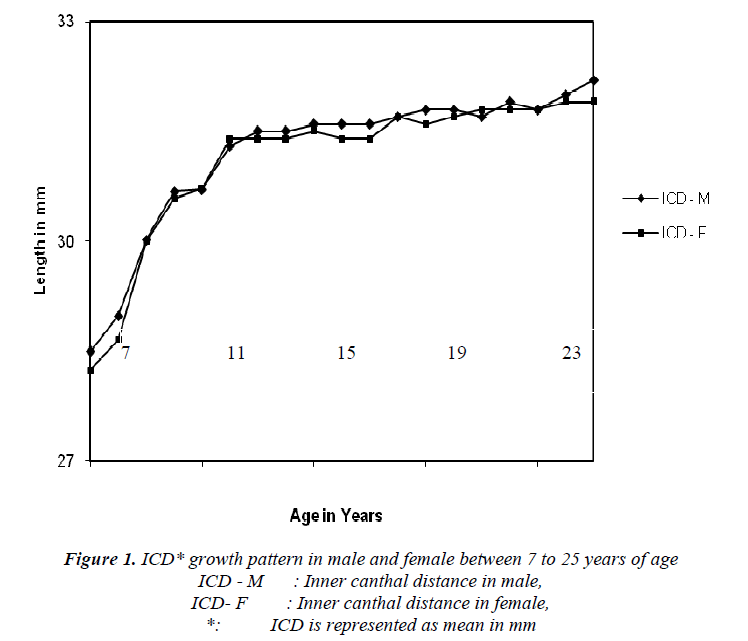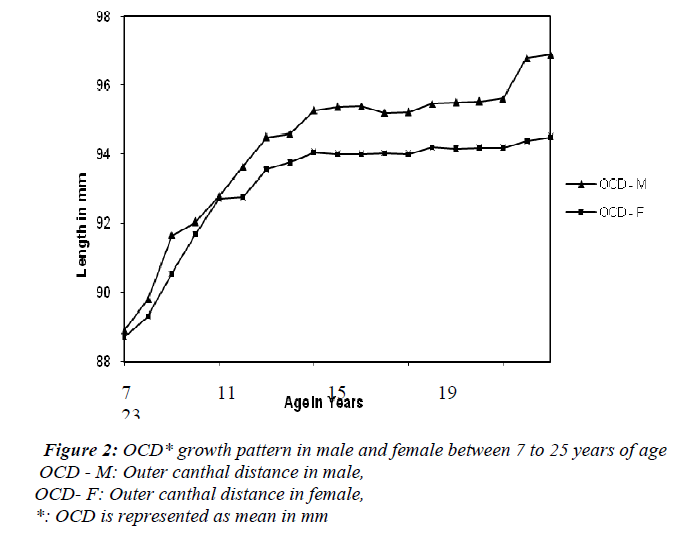ISSN: 0970-938X (Print) | 0976-1683 (Electronic)
Biomedical Research
An International Journal of Medical Sciences
- Biomedical Research (2013) Volume 24, Issue 3
Orbitofacial anthropometric assessment of inter-canthal and outercanthal distance measurement in Chhattisgarh region.
2Department of Anatomy, Sri Aurobindo Medical College and Postgraduate Institute, Indore, MP, India.
3Department of Ophthalmology, Pt. JNM Medical College, Raipur, Chattisgarh, India.
- Corresponding Author:
- Yogesh Sontakke
Department of Anatomy
Sri Aurobindo Medical College and Postgraduate Institute
Indore 452010 MP., India
Accepted date: February 06 2012
Citation:Agrawal J, Yogesh AS, Shukla CK, Banerjee C, Chandrakar AK. Orbitofacial Anthropometric Assessment of Intercanthal and Outer-canthal Distance Measurement in Chhattisgarh Region. Biomed Res- India 2013; 24 (3):365-369.
Orbitofacial anthropometrics have become an important tool used for diagnosis of many dysmorphic syndrome by genetic counselor and in reconstructive surgery. The study comprises of 1000 subjects (ages between 7 to 40 years) (515 males and 485 females) resident of Chhattisgarh region. Measurements of inner canthal distance (ICD) and outer canthal distance (OCD) were performed by Vernier caliper. In male, the mean values of ICD and OCD observed among children (age 7-14 years) were 30.53mm and 92.57 mm respectively; in young adults (age >14 to 25 years) were 31.82 mm and 95.69mm respectively; and in adults (age >25 to 40 years) were 32.50mm and 96.10mm respectively. In female, the mean values of ICD and OCD observed among children (age 7-14 years) were 30.44mm and 91.89 mm respectively; in young adults (age >14 to 25 years) were 31.70 mm and 94.16mm respectively; and in adults (age >25 to 40 years) were 32.00mm and 94.40mm respectively. All the measured parameters were found increasing between 7 to 25 years and the maximum growth in ICD and OCD were found in between 8 and 9 year in both sexes. All parameters measured were higher in males than in females, but the difference was not statistically significant.
Keywords
Anthropometry, intercanthal distance, outercanthal distance
Introduction
Canthus is either corner of the eye where the upper and lower eyelids meet. The inner canthus is called as nasal or medial cantus while Outer canthus is known as lateral or temporal canthus. The inner canthus represents the fleshy, pink lachrymal caruncle and the canaliculi which lead into the lachrymal sac. Anthropometry is the study of the systemic measurement of the different parts of the human body in order to determine their respective proportions [1,2]. Orbitofacial anthropometrics have become an important tool used by genetic counselor and in reconstructive surgery. The diagnosis of many dysmorphic syndromes is based on advanced cytogenetic and molecular techniques. Before referring a case for costlier molecular diagnostic tests, recognition of subtle morphological anomalies and corresponding useful diagnostic test should be determined.
Physical growth is a fundamental vital process and the common property of life. The normal distance between the orbits varies during embryogenesis and after birth in accordance with the general craniofacial development [3]. Hypertelorism is an excessive distance between eyes and it is an integral part of various syndromes, e.g. Cat eye syndrome [4]. Dysmorphic characters are usually reported by clinicians in descriptive terms such as ‘wide set eyes’, ‘broad nose’ or ‘large mouth’. However such descriptions are subjective. Anthropometric measurement can overcome these problems. Using both morphological features and measurements, the face can either be reconstructed (identifying the dead), superimposed or compared to a facial photograph (mistaken identities or missing persons) or for the reconstruction surgeries after accidents [5]. Congenital and posttraumatic deformities can be better treated with the knowledge of normal values for this region to produce the best esthetic and functional result [3,6]. Earlier many researchers have studies craniofacial parameters and come up with standard formulations based on ethnic or racial data (7-12). Hence, the present study was undertaken to find normative orbitofacial measurements of population residing in Chhattisgarh region. In addition, the relationship between orbitofacial dimensions and advancing age was explored.
Material and Methods
In the present study, 1000 subjects (ages between 7 to 40 years) (515 males and 485 females) were included. All these subjects were resident of Chhattisgarh region obtained from urban schools, students admitted in the medical college and the patients attended the ophthalmology OPD for refractive correction [otherwise normal] and resident of Chhattisgarh region. Inclusion criteria were age between 7 to 40 years and with normal craniofacial configuration. Exclusion criteria were the cases with the history of neurological disease, developmental disabilities, oculofacial trauma, craniofacial congenital anomaly, strabismus and clinically manifested telecanthus or epicanthus. The subjects were divided in three groups according to age as children of age between 7 to 14 years, young adults age more than 14 to 25 years and adults age more than 25 years upto 40years. Group of children included 195 boys and 192 girls, group of young adults included 263 males and 243 females and group of adults included 57 males and 50 females. Between age 7 to 25 years, the growth pattern was also studied yearly.
After being informed consent had been obtained, measurements of inner canthal distance (ICD) and outer canthal distance (OCD) were performed. For ICD ,the distance between the medial canthus of both eyes and for OCD the distance between the lateral canthus of both eyes were measured using digital Vernier caliper. Precautions taken during measurement were included cleanliness of instrument, check for Zero error and check for Parallax error (error due to wrong positioning of the eye). The subject was seated comfortably in the chair in a relaxed state and in an upright position with his/her head at the same level as the examiner’s head. The Vernier caliper was gently placed on the medial canthus and outer canthus of the eyes and the ICD and OCD were measured respectively. Data was analysed statistically using ‘t’ test. Difference of growth pattern according to sexual dimorphism was also studied.
Observation
ICD and OCD of both male and female for different age groups in Chhattisgarh region are given in table 1. In male, the mean values of ICD and OCD observed among children (age 7-14 years) were 30.53mm (minimum 25.61 mm, maximum 34.23 mm) and 92.57 mm (minimum 86.42 mm, maximum 100.24 mm) respectively; in young adults (age >14 to 25 years) were 31.82 mm (minimum 30.35 mm, maximum 36.38 mm) and 95.69mm (minimum 92.11 mm, maximum 103.31 mm) respectively; and in adults (age >25 to 40 years) were 32.50mm (minimum 30.85 mm, maximum 37.65 mm) and 96.10mm (minimum 93.41 mm, maximum 103.84 mm) respectively (Table 1). In female, the mean values of ICD and OCD observed among children (age 7-14 years) were 30.44mm (minimum 25.57 mm, maximum 33.98 mm) and 91.89 mm (minimum 85.98 mm, maximum 96.95 mm) respectively; in young adults (age >14 to 25 years) were 31.70 mm (minimum 30.20 mm, maximum 36.01 mm) and 94.16mm (minimum 90.84 mm, maximum 101.33 mm) respectively; and in adults (age >25 to 40 years) were 32.00mm (minimum 30.67 mm, maximum 36.89 mm) and 94.40mm (minimum 92.97 mm, maximum 102.02 mm) respectively (Table 1). Both the orbitofacial parameters i.e., ICD and OCD were found to be significantly higher in young adults than children (p value<0.001), but the differences were not significant between young adults and adults (p value >0.001) (Table 1). All the measured parameters were found increasing between 7 to 25 years (Table 2). In both sexes, the maximum increase of growth of ICD and OCD was found between the ages of 8 and 9 years (Table 2, Figure 1 and 2). All the measured parameters were higher in males than in females, but the difference was not statistically significant (p value >0.001) (Table 1 & 2, Figure 1 & 2).
Discussion
Functional and cosmetic craniofacial surgery involving the eyelids and eyebrows requires knowledge of the anatomic relationships of the landmarks as it is important in the human appearance [3]. Ocular adnexal changes and somatometric traits of the face such as epicanthus, telecanthus, flat nasal bridge, widely spaced eyebrows, and blepharophimosis may create an illusory fault in the identification of certain craniofacial syndromes, and reliable methods are needed for the diagnosis of some craniofacial anomalies [3,7]. Therefore, normal values for ICD and OCD are integral measurements in the evaluation of telecanthus and ocular hypertelorism. Congenital and posttraumatic deformities (e.g., traumatic telecanthus) can also be better treated with the knowledge of normal values for this region to produce the best esthetic and functional result. For these reasons, standards based on ethnic or racial data are desirable because these standards reflect the potentially different patterns of craniofacial growth resulting from racial, ethnic, and sexual differences. In the present study, age group of 7 to 40 years of age was taken because of the fact that younger children might not cooperate fully with examiner and based on the assumption that any increase in the measured parameters with the age would have stopped by age of 40 years.
Quant and Woo (1992) in Chinese population at the age 7 observed ICD as 33.3mm in male and 34 mm in female, Juberg et al (1975) in African population at the age 7 observed ICD as 30.60 ± 0.26 mm in male and 30.50 ± 2.20 mm in female and Evereklioglu et al (2001) in Turkish population at age 7 observed ICD as 28.33 ± 2.01 mm in male and 28.14 ± 1.93 mm in female [11,13-14]. In our study, we found ICD 28.49 ± 2.84 in male and 28.24 ± 1.52 in female at the same age.
In a study of Indian population Singh JR and Banerjee [1983] found the overall OCD were 8.44 cm. and 8.17 cm. for males and females respectively [8]. Our values are higher than this. Goel et al (1987) measured the OCD in Meret region (India) found OCD 11.11 cm. in male and 11.12 cm. in females of 13- 14 years of age [15]. Our values are lower than this at 14 years of age for both the sexes. Everekliglou et al. [2001] in Turkish population (7 to 40 years of age) observed OCD 87.07 ± 4.36 mm in male and 85.39 ± 3.78 mm in females [13]. Our values in this age group are quite similar to these values. Gupta VP et al (2003) found that the OCD ranged from 71 to 105 mm in females and 76 to 105 in males in Indian population of Delhi region (age ranged from 3 to 80 years) while our overall results are higher than all of these values [16]. In Latvian residents, Erika Nagles et al. [2005] observed the OCD 10.63 ± 0.58 cm in male and 10.06 ± 0.6 cm in female of 18 to 23 years age group [17]. Our values are lower than Erika Nagles values.
In the present study, all orbitofacial parameters i.e., ICD and OCD were found to be significantly higher in young adults than children but the differences were not significant in young adults and adults. This might be due to the primary spurt of the growth during childhood and due to the fusion of ossification centers in later age of life. All the orbitofacial parameters were found increasing between 7 to 25 years. The age at which maximum growth occurs was found to be between 8 to 9 years.
In conclusion, the present study documents the anthropometric variation pattern of the orbitofacial parameters of population residing at Chhattisgarh region and presents normative data for the measured parameters, specific for age and sex. This data may be used as an important tool for diagnosis of many dysmorphic syndrome by genetic counselor, in reconstructive surgery and for identifying dead or live person by forensic expert.
References
- Kolar JC, Salter EM. Craniofacial anthropometry practical measurements of the head and face for clinical, surgical and research use. Charls Thomas Publishar Ltd. USA 1996.
- Spencer F. ed. History of physical anthropology. Gerland, Newyaork and London 1997; pp-80.
- Farkas LG, Posnick JC, Hreezko TM, Prone GE. Growth pattern in orbital region. Cleft Palate Craniofacial J 1992; 29: 315-318.
- Gaard RA. Occular hyperteleorism of Greig – A congenital craniofacial deformity. Am J Orthodontics 1961; 47: 205-209.
- Lakshminarayana P, Janardhan K, Davis HS. Anthopometry for syndromology. Ind J Pediatr 1991; 58: 253-258.
- Laestadius ND, Aase JM, Smith DW. Normal inner canthal and outer orbital dimentions. J Pediatr 1979; 74: 465-468.
- Pryor HB. Objective measurements of interpupillary distance. Pediatrics 1969; 44: 973-977.
- Singh JR, Banerjee S. Normal values for interpupillary, inner canthal and outer canthal distances in an Indian population. Hum Hered 1983; 33:326-328.
- Fledelius HC, Stubgaard M. Changes in eye position during growth and adult life as based on exophthalmometry, interpupillary distance and orbital distance measurements. Acta Ophthalmol 1986; 64: 481-486.
- Murphy WK, Laskin DM, Richmond MS. Intercanthal and interpupillary distance in the black population. Oral Surg Oral Med Pathol 1990; 69: 676–680.
- Quant JR, Woo GC. Normal values of eye position in the Chinese population of Hong Kong. Optom Vis Sci 1992; 69: 152–158.
- Osuobeni EP, Faden FK. Interpupillary distance of females of Arab origin. Optom Vis Sci 1993; 70: 244- 247.
- Evereklioglu C, Yakinci C, Er H, Doganay S, Durmaz Y. Normative values of craniofacial measurements in idiopathic benign macrocephalic children. Cleft Palate Craniofac J 2001; 38: 260–263.
- Juberg RC, Sholte FG, Touchstone WJ. Normal values for intercanthal distances of 5- to 11-year-old American Blacks. Pediatrics 1975; 55: 431–436.
- Goel SP, Dayal SS, Rmesh Babu CS, Mathur SK, Agrawal AK, Batra JS. Anthropometric assessment of intecanthal, interpupillary and outer orbital dimentionsnormal range. J Anat Soc Ind 1987; 36(3): 160-166.
- Gupta VP, Sodhi PK, Pandey RM. Normal values for intercanthal, interpupillary and outer intercanthal distances in the Indian population. Int J clinc Pract 2003; 57(1): 25-29.
- Naegles E. Craniofacial anthrAopometry in a group of healthy Latvian residents. Actamedica Lituanica 2005; 12(1): 47-53.



